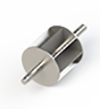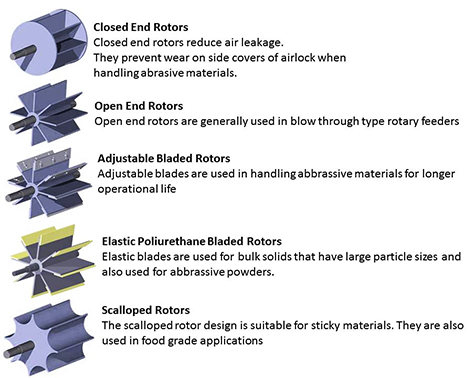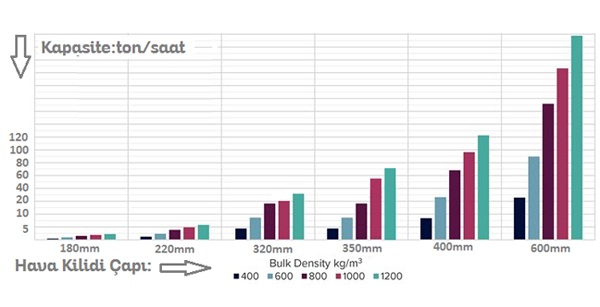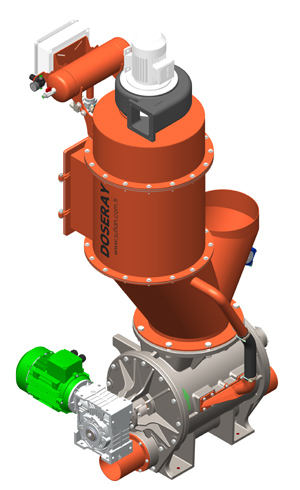Functions And Operating Modes Of a Rotary Valve
Generally a rotary valve has two basic functions: Discharging
and metering. Both the functions have
an additional task to establish an air lock point between two
sections of the system. Absolute air lock is
however not possible at the given pressure difference. The flow of
the leakage air can only be minimised.
Discharge
The basic function of pure discharging
is executed by the well-known basic rotary valve: In the
housing the rotor is revolving by constant speed. Due to gravity the
product comes out fromthe container or the hopper from the top
and falls in the chambers of the rotor. Due to the
revolving rotor the product is transported to the discharge
opening, from where it again moves down by
gravity. The rotary valve itself does not affect the flow capacity
of bulk solids. It depends on the chamber
volume, filling ratio and rotation speed.
Metering
The rotary valve for metering is
characterised by a variable speed, e.g. using a variable-pitch
geared motor or a frequency converter drive. The metering is purely
volumetric in such a case: A
specific volumetric flow per time
unit is set as the desired value in dm ³/s or m³/h. It is however
not measured so that there is an undefined
deviation between the desired and actual values.
The mass flow capacity is not measured and regulated, and therefore
the term, "metering" is actually incorrect in the
strict sense; a constant and reproducible volumetric flow can
however be set. The condition is, that
a) the density of
bulk solids is always constant,
b) the rotor is always fed with
the same filling ratio. This can be achieved, e.g. using an
agitator or a pneumatic discharge aid in the pre-hopper over the
rotary valve,
c) the chambers are emptied completely
Bulk Solids
Grains
Powder
Fine
powder
Grease (only with special model)
Granules
Application procedures
Discharging
Metering
Feeding
Protective System
Advantages:
• Space-saving, less installation height due to
built-in conveying air
connections in the housing
• Large
capacity range
• High operational safety due to sturdy design and
cleaning effect by
blowing out the rotor chambers
•
Cost-effective owing to low installation investment
• Low
maintenance due to simple assembly
• Less leakage air

ROTARY VALVE ROTOR TYPES
-







- Rotary Valve - Ailocks-Star Feeder internal
Rotors have options such as blade, rounded type, adjusted blade
type, stripper and polyamide. Discharging
valve for fine and coarse-grained products
Max. capacity through ideal ratio of rotor volume and inlet cross section
Special inlet geometry purpose-built for gentle product handling
With feeding show also suitable for feeding bulk materials into pneumatic conveying systems at up to 1.5 barg (21 psi) -

PDF
brochure

ROTARY VALVe characterıstıcs
• Sizes (entry): Æ 175, 200, 250, 300 mm
• Delivery rate: 0.3 - 50 m³/h
• Pressure shock resistant and
flame penetration resistant up to 10 bar (overpressure) with a
DMT certificate
• 1) The housing contains: horizontal conveying
pipe with a connecting flange for a
pneumatic conveying
pipeline
• 2) Emptying by blowing out the rotor chambers
horizontally using conveying air
• 3) Robust cast housing made
of GG, GS, 1.4308, 1.4408
• 4) Pressure-tight shaft seal with
radial shaft sealing rings and sealing air connection
• 5)
Integrated leakage air dissipation
• 6) External bearing
•
7) Chain drive with a geared motor attached laterally
Drop Thru Rotary Valve Models
- 120mm DRAW- cad
- 180mm DRAW-cad
- 200mm DRAW valve -cad
- 220mm DRAW-Cad -cad
- 320mm Draw-cad
- 320mm Long Type Draw -cad
- 350mm Draw-cad
- 450mm Draw-cad
Blow Thru Rotary Valve Models
While pneumatic transport processes differ according to the phases, it may also diffrent in the same phase. Low pressure, that is dilute phase transfer, can be categorized under 2 classes, namely vacuum and pressure. This classification shows, even slightly, differences in the rotary valve - airlocks. Consequently, we perform manufactures according to the air locks to be used on the vacuum and pressure line.
ROTARY VALVE capacıty


Rotary airlock feeders have wide application in industry wherever dry
free-flowing
powders, granules, crystals, or pellets are used.
Typical materials include: cement,
ore, sugar, minerals, grains,
plastics, dust, fly ash, flour, gypsum, lime, coffee,
cereals,
pharmaceuticals, etc...
- Lebels: rotary valve, rotary airlock, airlock valve, rotary feeder, blow through rotary valve, flow through airlock, silo discharge, cyclone discharge, dust collection, pneumatic conveying, rotary air lock valve, rotary valve producer, rotary valve price, rotary valve tecnichal draw

